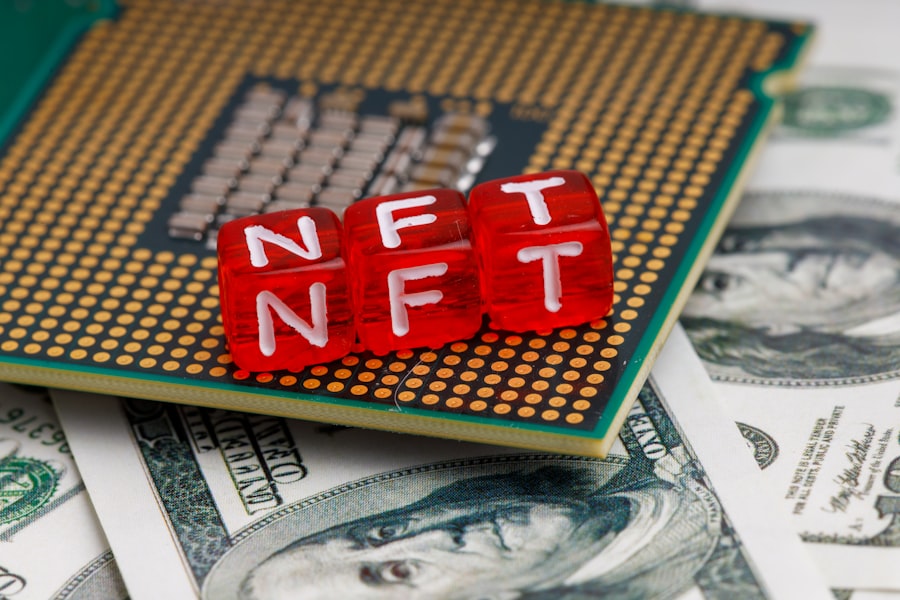Non-fungible tokens (NFTs) are unique digital assets that represent ownership or authenticity of specific items or content, such as artwork, music, videos, or tweets. Unlike fungible cryptocurrencies like Bitcoin or Ethereum, NFTs cannot be exchanged on a one-to-one basis due to their unique nature. NFTs utilize blockchain technology, a decentralized digital ledger that records transactions across a computer network.
This technology ensures NFT authenticity and ownership, making counterfeiting or duplication extremely difficult. NFTs have gained popularity in various industries, including art, music, gaming, and sports memorabilia, providing creators with new monetization opportunities and collectors with unique digital assets. The value of an NFT is influenced by factors such as scarcity, demand, and creator reputation, making them potential investments for both creators and collectors.
However, NFTs have faced criticism regarding their environmental impact due to the energy-intensive processes of minting and trading. Despite these concerns, NFTs continue to gain traction in the digital world, with an increasing number of creators embracing this new form of digital ownership and expression.
Key Takeaways
- NFTs are unique digital assets that represent ownership of a specific item or piece of content on the blockchain.
- Buying and selling NFTs involves using cryptocurrency and participating in online marketplaces or auctions.
- Navigating the NFT marketplace requires understanding different platforms, fees, and the process of transferring ownership.
- Creating and minting your own NFTs involves choosing the right platform, understanding gas fees, and ensuring proper copyright and ownership rights.
- Legal and ethical considerations of NFTs include copyright infringement, environmental impact, and potential scams.
How to Buy and Sell NFTs
Buying and selling NFTs can be an exciting and potentially lucrative endeavor, but it’s important to understand the process before diving in. The first step in buying an NFT is to set up a digital wallet that supports the specific blockchain on which the NFT is minted. Popular blockchains for NFTs include Ethereum, Binance Smart Chain, and Flow.
Once you have a digital wallet set up, you can then browse NFT marketplaces such as OpenSea, Rarible, or NBA Top Shot to find the NFT you want to purchase. When you find an NFT you’re interested in, you can place a bid or buy it outright using cryptocurrency. Selling an NFT follows a similar process, but in reverse.
You’ll need to create the NFT using a process called “minting,” which involves uploading the digital asset to a marketplace and creating a unique token that represents ownership of the asset. Once the NFT is minted, you can list it for sale on a marketplace and set a price or auction for potential buyers to bid on. When a buyer purchases your NFT, the transaction is recorded on the blockchain and the ownership of the digital asset is transferred to the buyer’s digital wallet.
It’s important to note that buying and selling NFTs involves transaction fees and gas fees, which can vary depending on the blockchain and marketplace used. Navigating the NFT Marketplace Navigating the NFT marketplace can be an overwhelming experience for newcomers, but with the right knowledge and tools, it can also be an exciting opportunity to explore and invest in unique digital assets. There are several popular NFT marketplaces where creators can mint and sell their NFTs, including OpenSea, Rarible, Foundation, and NBA Top Shot.
Each marketplace has its own set of features, fees, and community, so it’s important to research and compare different platforms before choosing where to list your NFTs. When browsing the NFT marketplace as a buyer, it’s important to do thorough research on the creator, the authenticity of the digital asset, and the potential for future value appreciation. Some marketplaces offer features such as “verified” or “authenticated” badges for creators with a proven track record or celebrity status.
Additionally, some marketplaces offer curation or editorial features that highlight trending or high-quality NFTs for buyers to discover. As a seller, it’s important to consider factors such as listing fees, royalties, and exclusivity when choosing a marketplace to mint and sell your NFTs. Creating and Minting Your Own NFTs Creating and minting your own NFTs can be a rewarding way to showcase your digital art, music, or other creative works while potentially earning income from their sale.
The process of minting an NFT typically involves uploading your digital asset to a marketplace, setting parameters such as edition size and royalties, and paying a gas fee to record the transaction on the blockchain. Some marketplaces also offer additional features such as unlockable content or special perks for buyers of your NFTs. When creating your own NFTs, it’s important to consider factors such as copyright ownership, licensing rights, and potential legal implications.
If you’re using existing content or collaborating with others on a project, it’s crucial to have clear agreements in place regarding ownership and royalties. Additionally, it’s important to consider the long-term value and potential demand for your NFTs when setting parameters such as edition size and pricing. The Legal and Ethical Considerations of NFTs The rise of NFTs has brought about legal and ethical considerations that creators and collectors should be aware of when participating in this emerging market.
One of the key legal considerations is copyright infringement, as minting an NFT of someone else’s work without permission can lead to legal repercussions. It’s important for creators to ensure they have the rights to the content they are minting as an NFT, whether it’s original work or licensed from another creator. Ethical considerations also come into play when it comes to environmental impact and sustainability.
The process of minting and trading NFTs requires significant energy consumption, leading to concerns about carbon footprints and environmental damage. Additionally, there have been cases of plagiarism and fraud in the NFT space, highlighting the importance of due diligence and authenticity verification when buying or selling NFTs. Investing in NFTs: Risks and Rewards Investing in NFTs can be an exciting opportunity for potential financial gain, but it also comes with its own set of risks and uncertainties.
The value of an NFT is largely driven by factors such as scarcity, demand, and the reputation of the creator. While some NFTs have sold for millions of dollars, there is also a risk of investing in assets that may not appreciate in value over time. One of the key risks of investing in NFTs is market volatility.
The value of NFTs can fluctuate significantly based on trends, hype, and market sentiment. Additionally, there is a lack of regulation in the NFT space, which can lead to potential scams or fraudulent activities. It’s important for investors to do thorough research and due diligence before investing in NFTs and to be mindful of their risk tolerance.
On the other hand, investing in NFTs also presents potential rewards for creators and collectors. For creators, minting and selling NFTs can provide a new stream of income and exposure for their work. For collectors, owning unique digital assets can be a way to support their favorite creators while potentially earning returns on their investment if the value of the NFT appreciates over time.
The Future of NFTs: Trends and Innovations The future of NFTs holds exciting potential for continued growth and innovation in the digital art and collectibles space. As more artists, musicians, and creators embrace NFTs as a way to monetize their work, we can expect to see new trends and innovations emerge in the marketplace. One trend that has gained traction is the integration of augmented reality (AR) and virtual reality (VR) technology with NFTs, allowing collectors to experience their digital assets in immersive ways.
Another trend is the rise of fractionalized ownership of NFTs, where multiple investors can own shares of a high-value NFT. This opens up opportunities for more people to participate in owning rare or expensive digital assets while spreading out the financial risk. Additionally, we can expect to see more traditional industries such as real estate and luxury goods explore the potential of using NFTs for ownership records and provenance verification.
In terms of innovations, we may see advancements in blockchain technology that address concerns about energy consumption and environmental impact associated with minting and trading NFTs. There is also potential for new marketplaces and platforms to emerge that offer unique features and services tailored to specific niches within the NFT space. In conclusion, non-fungible tokens (NFTs) have emerged as a revolutionary way for creators to monetize their digital assets while providing collectors with unique ownership opportunities in the digital world.
Understanding how to buy and sell NFTs involves navigating various marketplaces and considering legal and ethical implications. Creating and minting your own NFTs requires careful consideration of copyright ownership and potential demand. Investing in NFTs presents both risks and rewards for creators and collectors alike.
Looking ahead, the future of NFTs holds exciting potential for continued growth and innovation in the digital art and collectibles space.
If you’re interested in learning more about the world of non-fungible tokens (NFTs), you might want to check out the article “Hello, World!” on eth-news.com. This article provides a beginner-friendly introduction to the basics of blockchain technology and how it relates to NFTs. It’s a great starting point for anyone looking to dive into the world of digital collectibles and unique digital assets. (source)
FAQs

What is an NFT?
An NFT, or non-fungible token, is a digital asset that represents ownership or proof of authenticity of a unique item or piece of content using blockchain technology.
How do NFTs work?
NFTs work by using blockchain technology to create a digital certificate of ownership for a specific item or piece of content. This certificate is then stored on a decentralized ledger, making it tamper-proof and easily verifiable.
What can be turned into an NFT?
Almost anything digital can be turned into an NFT, including artwork, music, videos, virtual real estate, collectibles, and even tweets or memes.
How are NFTs bought and sold?
NFTs are bought and sold on online marketplaces that support blockchain technology, such as OpenSea, Rarible, and Foundation. Transactions are typically conducted using cryptocurrency, such as Ethereum.
What are the benefits of owning an NFT?
Owning an NFT provides proof of ownership and authenticity for a digital item, and it can also potentially increase in value over time, similar to physical collectibles or artwork.
Are there any risks associated with NFTs?
Some of the risks associated with NFTs include market volatility, potential for copyright infringement, and the environmental impact of blockchain technology. It’s important for buyers to do their research before investing in NFTs.





